Hi guys,
Eric-Jan asked me the show this thread also here on the WAF forum, so here it goes.
A few weeks ago I acquired this Soldbuch of a Fahnenjunker / Oberfeldwebel in the Fallschirmjäger Regiment 5, of the 3. Fallschimjäger division.
Unfortunally the pictures are missing in the soldbuch and driverslicense, but there I have a big passion for the fighting in the Ardennes and Hürtgenwald I couldn't let this one go.
I have quite some books about this battle and unit, and lately acquired another nice book, and in this book I found my owner of the soldbuch twice, as he was Zugführer in the II.Batl./5 (FSJ).
I tried to type out the battles his unit fought (II.Batl./5) and I hope you find it interesting to read.
I also decorated the topic a little bit with some other material I had...
Kind regards,
Nick
Document grouping from:
Fahnenjunker / Oberfeldwebel Johannes Richter
Zugführer in the 6. Kompanie, II. Bataillon,
Fallschirmjäger Regiment 5, der 3. Fallsch.Jg.Div.
Grouping consists of:
Soldbuch Luftwaffe (without picture) issued on 3 September 1939.
Wehrmacht Führerschein issued on 12 January 1940.
Verplichtungsschein, 1 October 1932.
Schiessbuch from the years: 1932, 1933, 1934, 1935, 1936.
Besitzzeugnis Spanien Kreuz in Silber.
Besitzzeugnis Eisernes Kreuz II. Klasse.
Besitzzeugnis Verwundeten Abzeichen in Schwarz.
Besitzzeugnis Verwundeten Abzeichen in Silber.
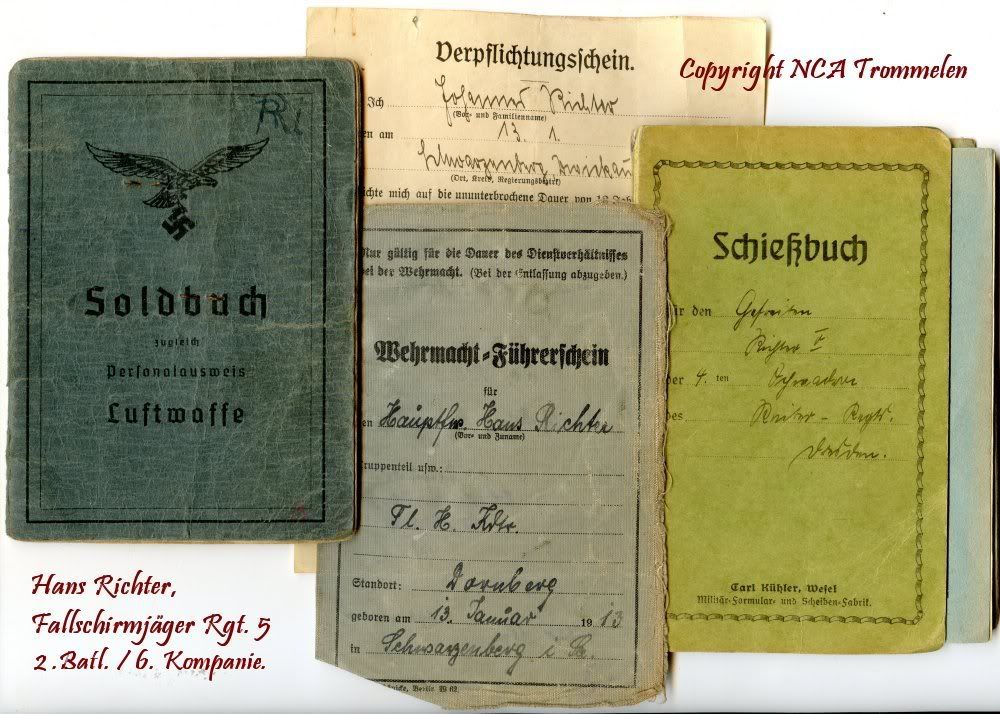
Johannes Richter which was born on 13 January 1913 in Schwarzenberg, Vogtland. Starts his military carrier on 1 October 1932, signing off for 12 years of service in the German “Heer”.
His soldbuch was issued on 3 September 1940.
Erkennungsmarke No. 145.
Blutgruppe B.
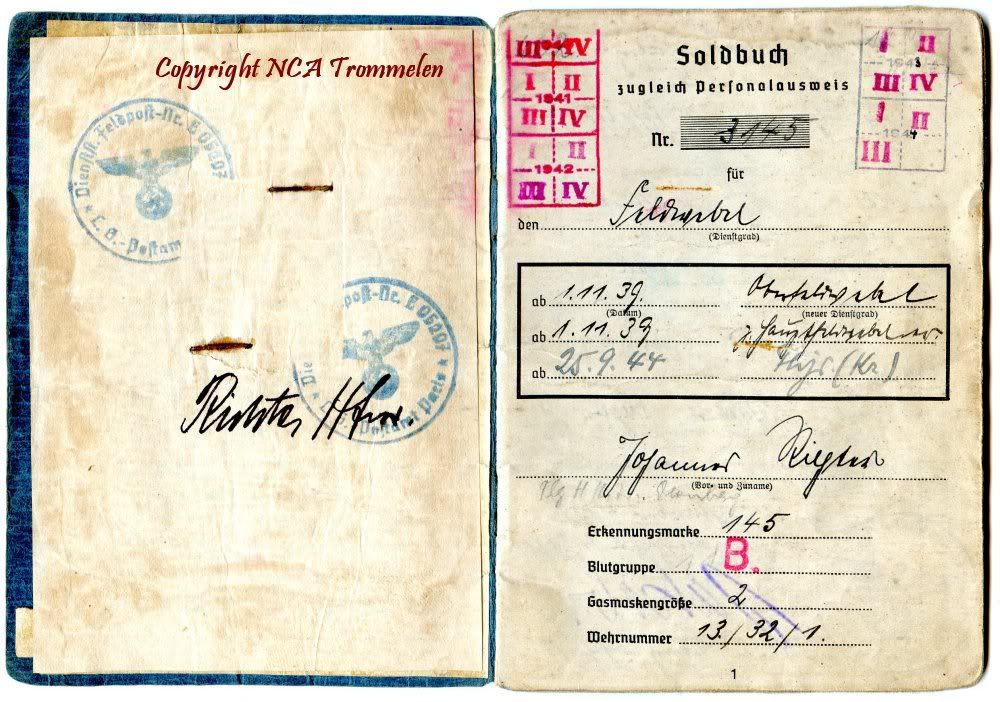
In 1939 he already received the rank of Feldwebel, and on 1 November 1939 a promotion follows listing him as Oberfeldwebel / Hauptfeldwebel. Before that he also earned the Spanien Kreuz in Silber during the Spanish civil war.
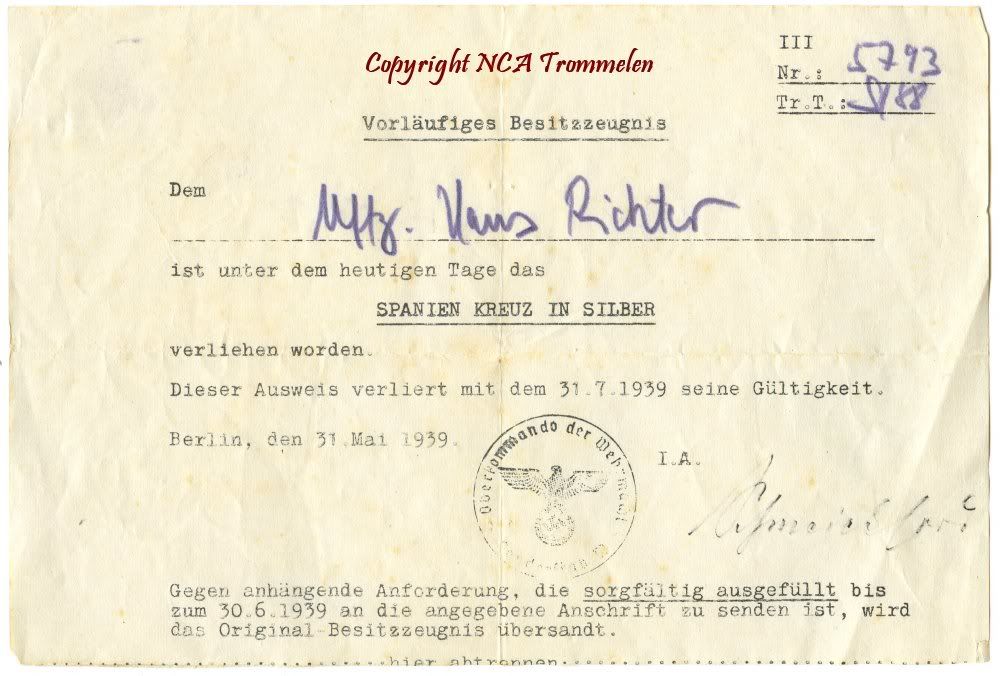
Spanien Kreuz in Silber document.

His promotions listed in the soldbuch.
His First unit in the soldbuch is Fliegerhorst Kompanie (E) Dornberg, in this unit he will stay for allmost 4 years. This unit, part of Fliegerhorst Dornberg/Schlempertshof was located near Würzburg. And was build in the beginning of the Poland 1939 campaign.
The unit wasn’t much active, also it was in reserve during the France campaign in 1940.
After the German troops had taken over France in July 1940, the Fliegerhorst was abandoned and the unit moved to France, near Barosmesnil. During this small 4 years of duty with the Luftwaffe, Oberfeldwebel Richter will earn the Kriegsverdiensten Kreuz, II. Klasse mit Schwertern on 6 May 1942.
On July 1943 he stays 2 months with the Reserve Grenadier Bataillon 372, which is reserve for the 372. Infanterie Regiment. In this unit he only will stay a few weeks before he is back again to his old unit: Fliegerhorst Kompanie 40/XIII. Here he will stay again for 8 months.
After that he is transferred to the Seefliegerhorst Kompanie until September 1944.
Until now he had done some easy time in the German army which was losing the war as this point. In desparete need of new men / soldiers many Luftwaffe, Kriegsmarine and other units that where out of “work” because for instance there where no more planes to fly, these men where going to be trained for ground combat.
Oberfeldwebel Richter is transferred to the Fallschirm Schule II on 27 September 1944, where he will see training in the Fallsch.Jg.Ers.Btl. Stendal, which is training new recruits / reserves for the 3. Fallsch.Jg.Div. Just a few days before going to the Ersatz unit, he is promoted to Fahnenjunker / Oberfeldwebel, on 25 September 1944.
During his training he will receive new equipment and also a Karabiner 98 rifle with bayonet, on 5 October 1944.
His training, beginning at the end of September, will only last a poor 6 weeks for he is already send to the frontline unit: the 3. Fallsch.Jg.Div.
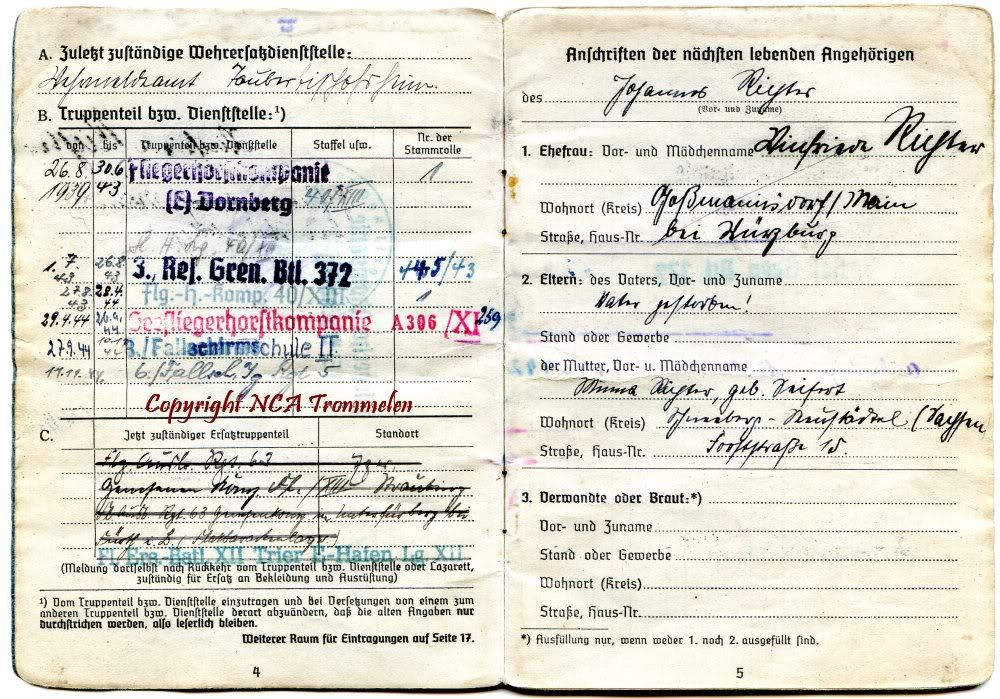
His units listed in the Soldbuch.
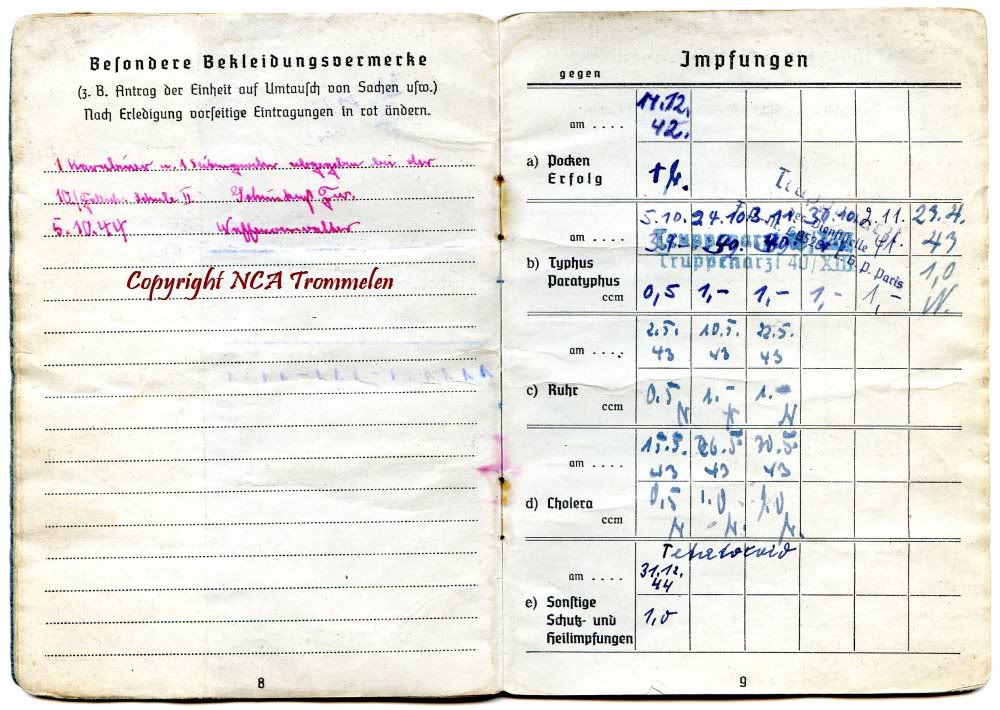
K98 with Bayonet recieved by the Fallschirm Schule II.
On 11 November 1944, he becomes Zugführer in the 3. Fallschirm.Jg.Div., Regiment 5,
II. Bataillon, 6. Kompanie.
The 3. Fallsch.Jg.Div. who suffererd heavy losses in the Normandy campaign, Falaise Pocket, Mons Pocket and Market Garden campaign was very under strengthened at this point.
Many Ersatz / Replacement units where to follow to strengthen up the Division.
Johannes Richter was one of them.
Hürtgenwald campaign.
The divison who was rebuilding at Oldenzaal (Holland) was send to the frontline near Aachen on November 1944, where the Fallschirmjäger Regiment 5 stays in Reserve near the town of Horm. Other Regiments of the 3. Fallsch.Jg.Div, the FJR.8 and FJR.9 are already thrown into combat in the region of east of Eschweiler, in the triangle Nothberg – Schönthal – Inden, and to the south in the Meroder Wald.
This sector was defended by the 47. Volksgrenadier Div. and 12. Volksgrenadier Div. from October 1944 untill now and was heavily weakenend by US attacks of the 1. US.Infantry.Div. “Big Red One”, and the 3. US.Armoured.Div.
The 12. Volksgren.Div, which consists of the following regiments: Füs.Rgt.27 – Gren.Rgt.48 – Gren.Rgt.89 only consisted of a total of 180 man that were deployed at the HKL (main frontline).
For the 47. Volksgren.Div. the following numbers occur: Gren.Rgt 103 – Gren.Rgt.104 – Gren.Rgt. 115: Has a total of 311 combat ready soldiers at the frontline at the end of November 1944. Looking at this numbers, it makes sence the 3. Fallschirm.Jg.Div. was trown into battle in this region to protect the Allies for advancing to the Ruhr river.
Around the end of November the FJR.9 is deployed to the north between Lamersdorf and Langerwehe with parts of the FJR.8.
Other parts of the FJR.8 and (Rgt.Stab and the I. Batl.) together with the 3. Kompanie of the FJR.5 are deployed to the south between the town of Gey and Haus Hardt.
The Meroder Wald, between Jüngersdorf and Haus Hardt was assigned to the FJR.5
The II. Batl./5 (where Richter was assigned to) was to take positions about 3km’s west of Merode up to 400m south of Jüngersdorf where it was to relieve the III.Batl./5 that already lost about 230 men in this sector, at the first days of fighting.
On this spot they were to hold further attacks made by the 1.US.Infantry.Div. “Big Red One”.
Nonetheless the II.Batl./5 was slowly driven back to the east edge of the Meroder Wald and dug in there on the 28 November 1944.
The US forces, now advancing to Merode itself had launched a major attack on the 3 German Fallschirmjäger Bataillons in the Meroder Wald. The II.Batl./5 got struck by an majority of US forces 1 to 8, and was overrun and pushed back in the town of Merode.
The day after on 29 November 1944 the I.Batl./5 was to attack together with the II.Batl./5 and the Rgt. Units 13., 14 and 15./5 to counterattack the US forces in Merode, and they succeeded . They had driven the Americans back to the forest of Merode.
Immediately after the German success the US forces attacked again with heavy Artillerie preparations, and some of the houses where back again in American hands. As the US forces were halted a few moments later, the 2. Kompanie of the FJR.5 counterattacked, destroying one of the 7 US tanks that were engaged in the fighting. The other 6 tanks, that where under tremendous fire, couldn’t hold it any longer and the crews of the tanks bailed out and ran back to the secure forest of Merode that was in US hands. Leaving 6 US tanks abandoned in the frontline, which were later destroyed with Panzerfausts by the 15./5.
The American infantry still in the outskirts of Merode were hiding in the basements of the houses when they heard that the German Fallschirmjägers got reinforced by an Tiger tank, which was blasting in all the houses that the US infantry occupied.
Many US prisoners were made, and Merode was back in German hands.
On 30 November 1944 Fhj./Ofw. Richter was hit by grenade shrapnel in the upper lef leg. The wound occurred to be only a light one and he stayed on the frontline with his Zug of the 6. Kompanie. The area where he got hit must had been NE of Merode, towards Jüngersdorf.
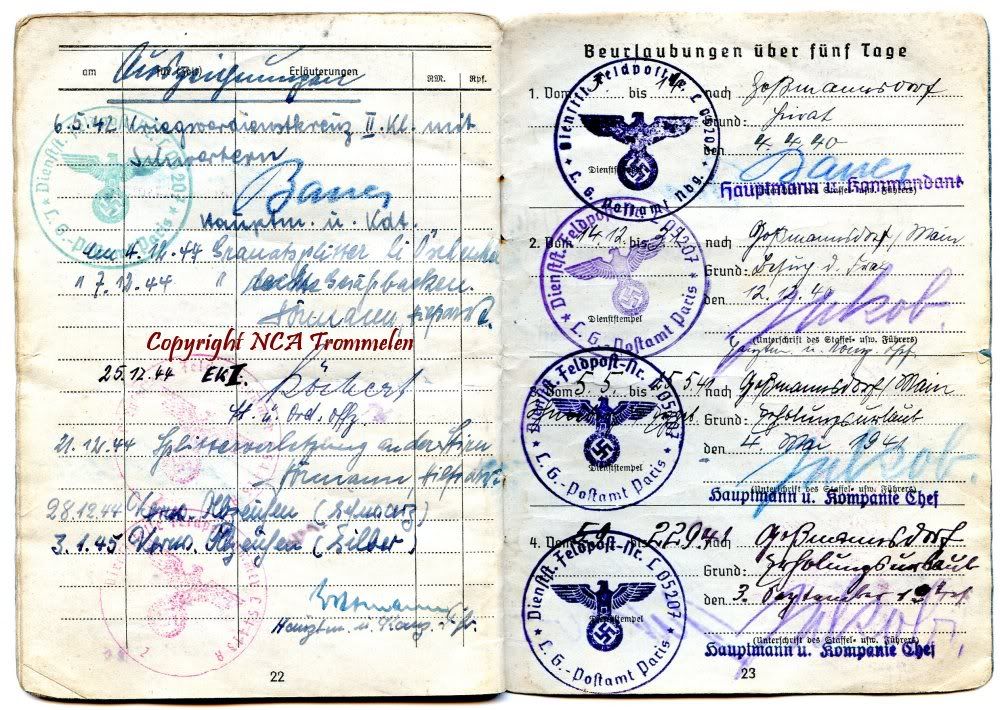
His wound description in the soldbuch, together with more descriptions of wounds that were to come.
Also his awards are listed on this page.
In the following days many fights where to occur in and around Merode, on 4 December 1944 the recaptured ground between the West of Jüngersdorff and the Forsthaus Merode is defended by the 1. Kompanie and by the 6.Kompanie of Fhj./Ofw. Richter, it is on 4th day of this defence, 8 December 1944 , that Fhj./Ofw. Richter will receive his 2nd injury while defending this heavily fought terrain. He was hit by grenade shrapnel in the right buttocks.
This 2nd wound in a week will earn him the Verwundeten Abzeichen in Schwarz later.
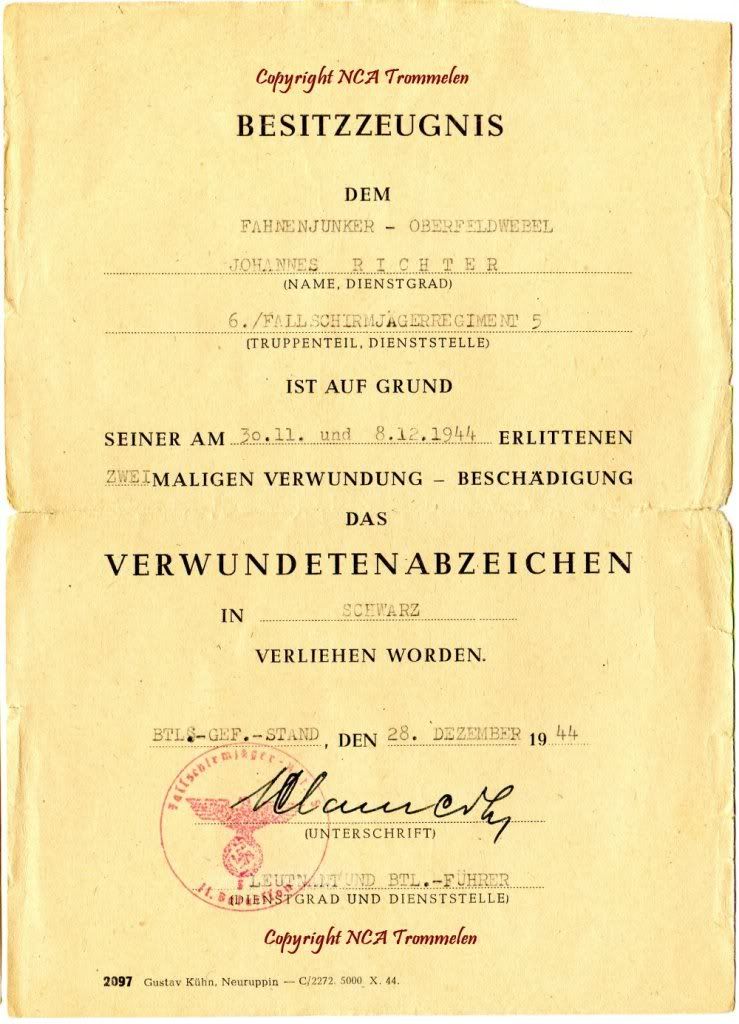
VWA Document showing his 1st and 2nd wound during the battle for Merode. He has been awarded with the VWA in Schwarz.
The document is signed during the Ardennes offensive by Adolf Klammert, leader of the II.Batl./5.
This wound will be received on one of the last days the FJR.5 was in the vicinity of Merode, the following day the Americans will launch a major attack and the Fallschirmjägers where driven back towards the line Obergeich – Konzendorf.
Here they will not hold any long, on the open terrain with the Americans in the higher Meroder Wald above, they are chanceless. Around 10 December 1944 the frontline shifts towards Düren. The fighting’s will continue in the vicinity of Merken – Hoven – Mariaweiler, where the 3. Fallsch.Jg.Div. will engage the US forces till mid December.
The Fallschirmjäger Rgt. 5 was the Regiment with the most casualties of the 3. Fallsch.Jg.Div. during the Merode/Hürtgenwald fighting’s early December 1944, the Bataillon of Fhj./Ofw. Richter will list 430 casualties, of the total 1658 casualties the Regiment had, in that periode of a small 2 weeks.
Ardennes offensive.
The most part of the 3. Fallsch.Jg.Div. was pulled back from the Merken – Hoven – Mariaweiler frontline just a few days before the December 16th,, 1944 = the day the Ardennes offensive started.
The units where send on foot towards Schmidtheim - Hallschlag and Kronenburg, where it received orders to attack on the December 16th.
It must be stated that several units of the 3. Fallsch.Jg.Div. still fought around Düren during the beginning days of the Ardennes offensive! So the 3. Fallsch.Jg.Div. was pretty under strengthened when the Division attacked in the vicinity of Losheim in the early morning of December 16th.
The FJR.5 who had suffered the most losses during the fighting near Merode was ordered to attack together with the FJR.8 towards Krewinkel, a small town on the German border in the vicinity of Losheim. They were ordered to capture the town before 0930 hours in the morning on the 16th of December.
The units that where to attack to town of Krewinkel consisted of the Sturm Zug II. Batl./5, Nachtrichten Zug II.Batl./5, and the 5.., 6., and 7. Kompanie of the II.Batl./5.
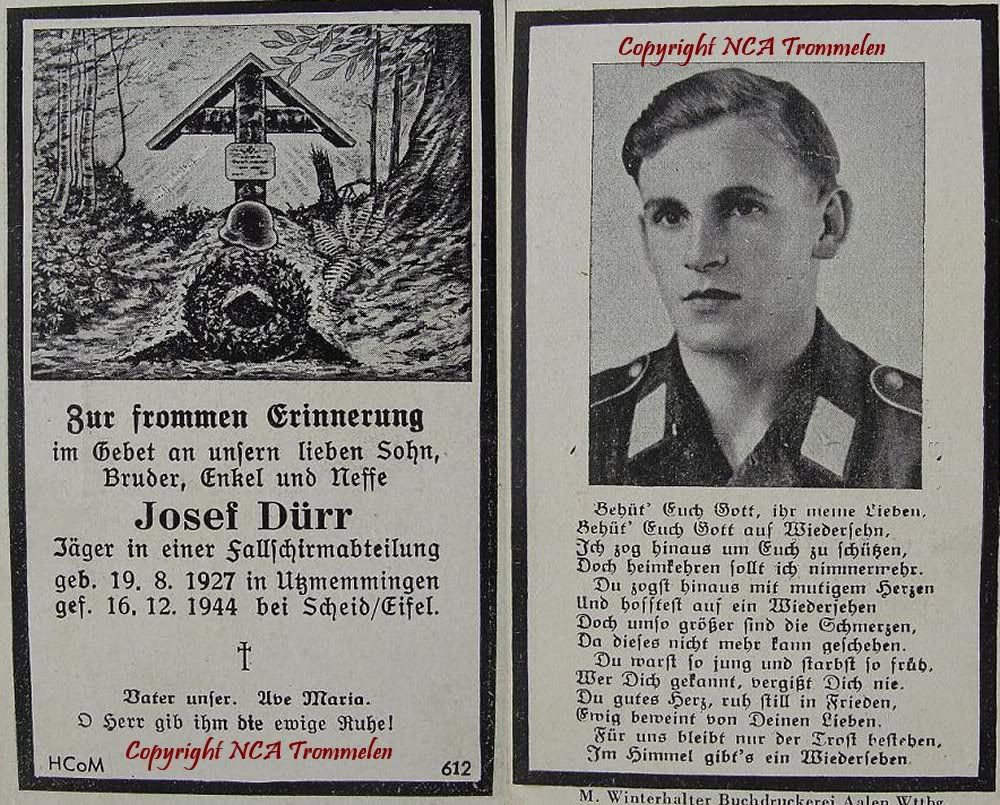
Deathcard above is in honour to a Jäger that fell on the first days of the offensive near Scheid (Losheim). Looking at the location of his death he probably belonged to a unit in the Fallschirm Regiment 9.
American units defending the town where the 14th Cav.Group., which was located between the lines of the US 99. Inf.Div to the North from Losheimergraben, and the US 106. Inf.Div. in the Schnee-Eifel.
After intense Artillery preparations by the Germans on the early morning of the 16th they discovered that the US frontlines where not smashed by the Artillery bombardments as aspected. In fact, most of the trenches and dugouts held by the 14th Cal.Group where still intact.
Therefore the fighting in and around Krewinkel by the II.Batl./5, and Richters 6. Kompanie was hard, and they did not manage to capture the town before late afternoon.
The II.Batl./5 was then send to seize the town of Manderfeld, which they did not achieve on the 16th, but only on the 17th of December! Heavy close combat fighting in Manderfeld occurred, after capturing Manderfeld Richter’s II.Batl./5 was order to seize Holzheim the same day, where the fighting was nonetheless the same.


Hallschlag, behind the German frontline. The first American prisoners are shifted to the rear. As the columns of SS and Fallschirmjägers are moving to the front.
As members of the Fallschirm Regiment 5 reached for Holzheim and the terrain surrounding the village. SS Grenadiers and members of the Fallschirm Regiment 9 attacked towards Honsfeld, a village North of Holzheim.
The Germans attacked the village of Honsfeld not knowing it was a resting-center for the 99 US. ID and 14th Cav.Group. Heavy street fighting occurred and at the end of the battle the small town was scattered with dead soldiers, from both sides.
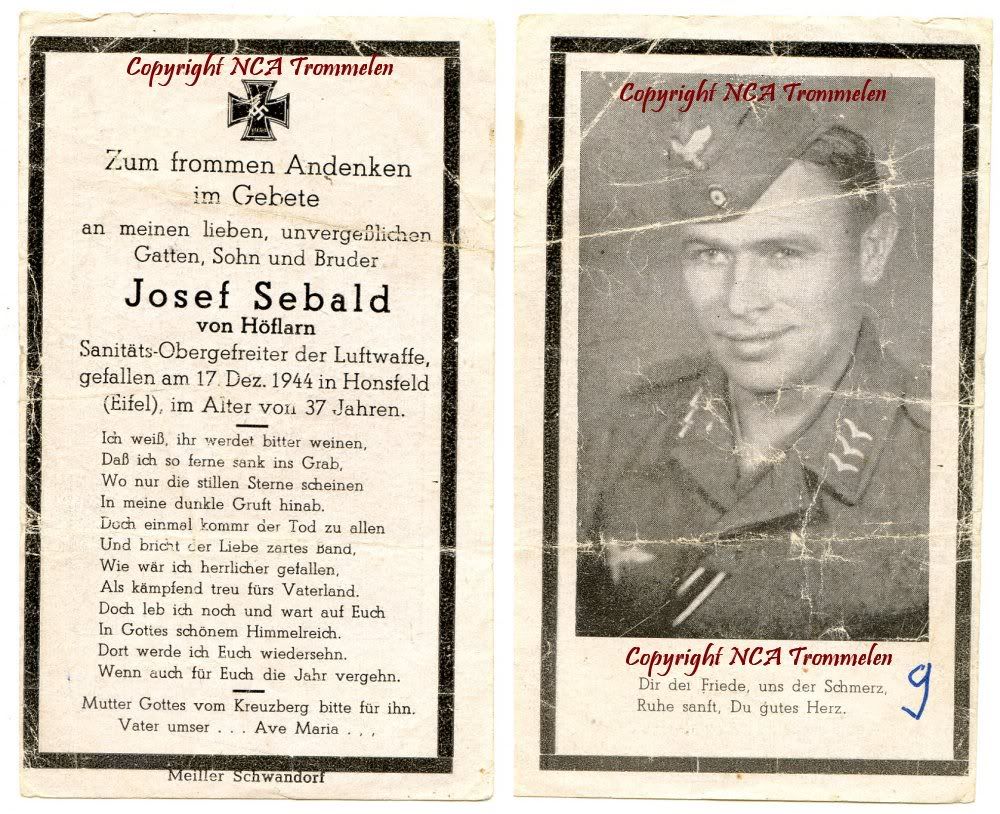
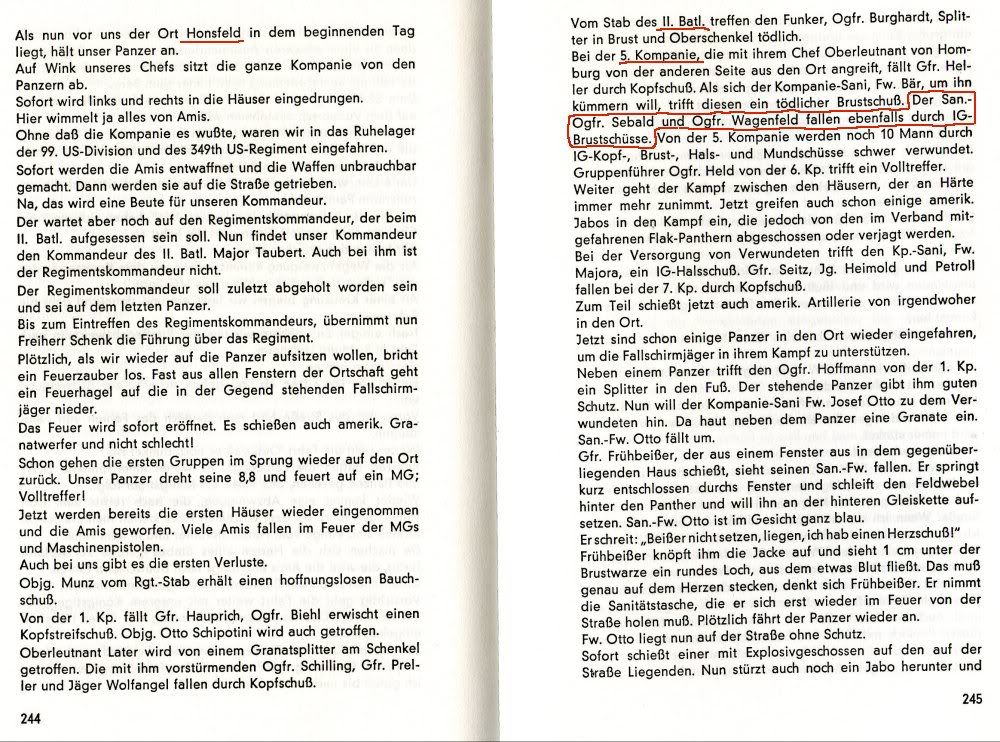
This Sanitäter, fell during the battle for Honsfeld. Allthough the deathcard doesn’t mention anything related to the Fallschirmjäger truppen, I found him back in Frühbeissers book.
Josef Sebald, a Sanitäts-Obergefreiter belonged to the II.Batl./9, 5. Kompanie.
And got hit by a piece of shrapnel in the breast. Ending his life at 37 years in the streets of Honsfeld.
He is buried at the war cemetery in Lommel.
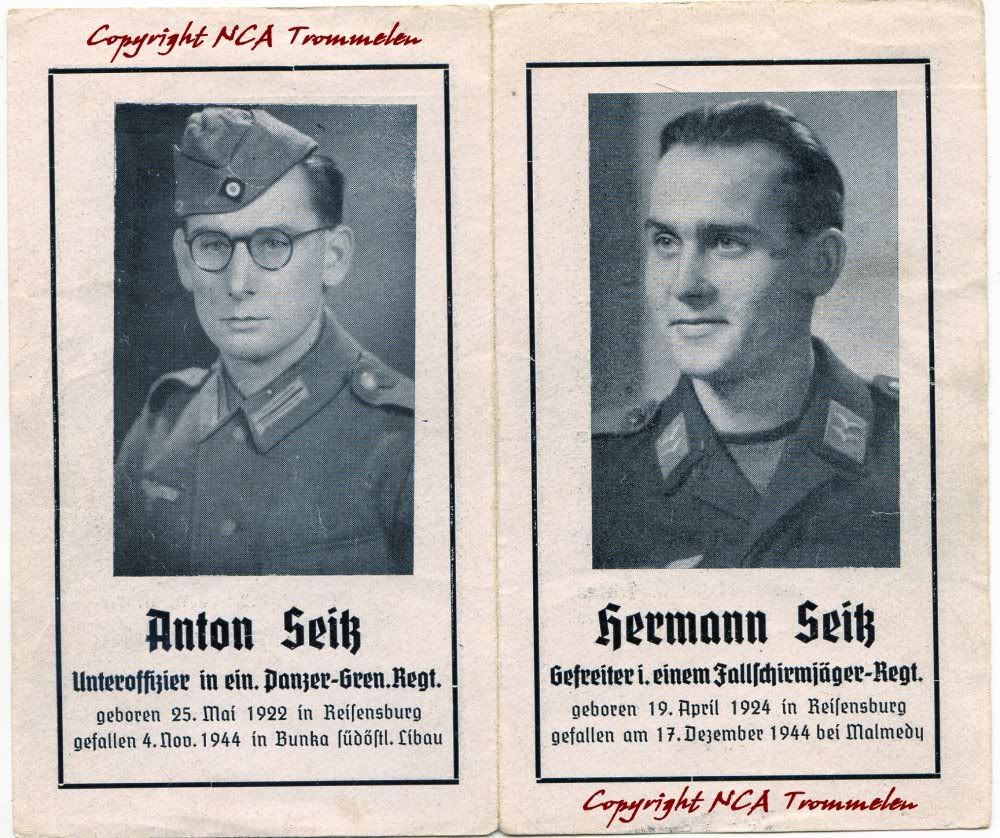
Picture above shows another member of the 3.Fallsch.Jg.Div., who also died on December 17th 1944, the card shows he got killed near Malmedy, but most likely he was also killed in the vicinity of Honsfeld or further towards Bütgenbach. He is also buried at the war cemetery in Lommel.

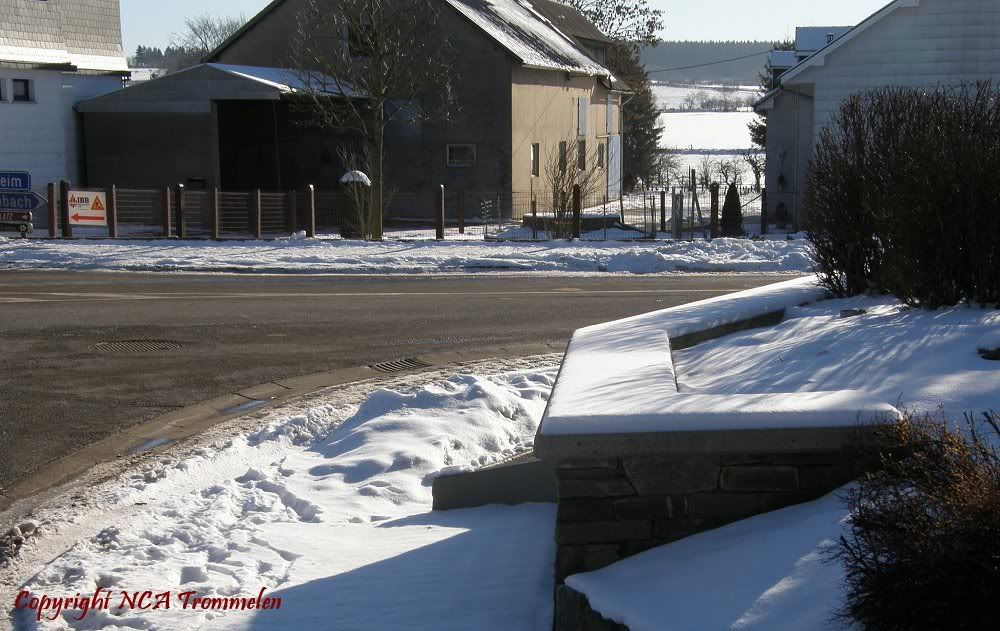
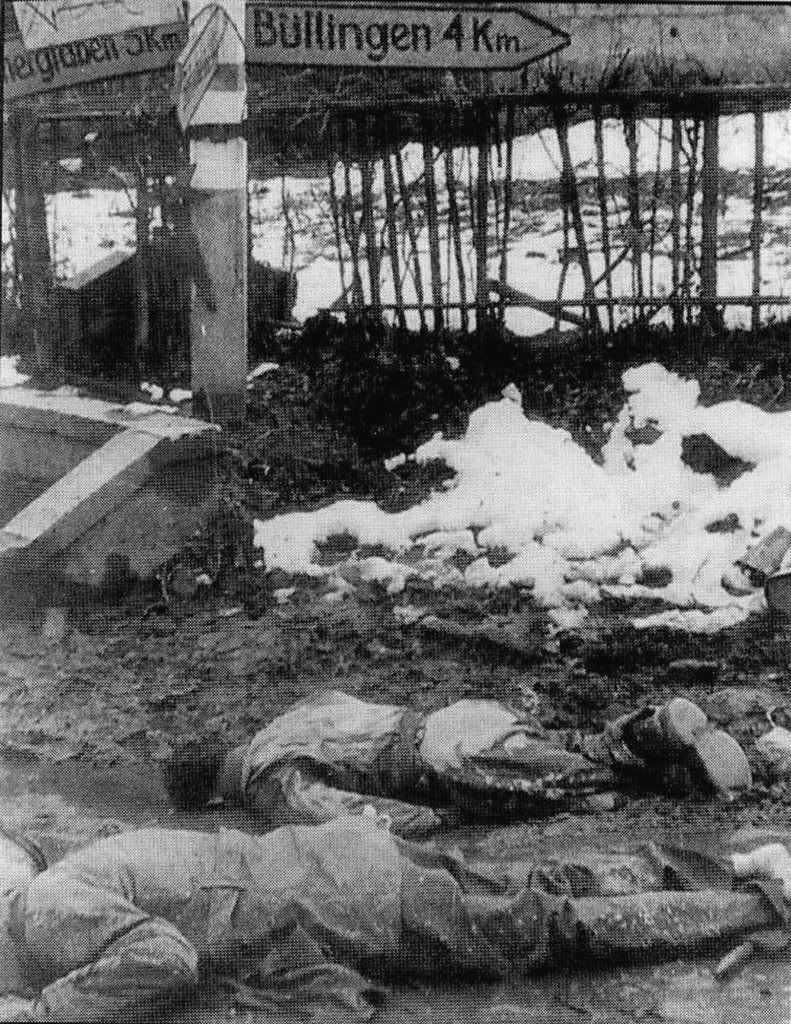
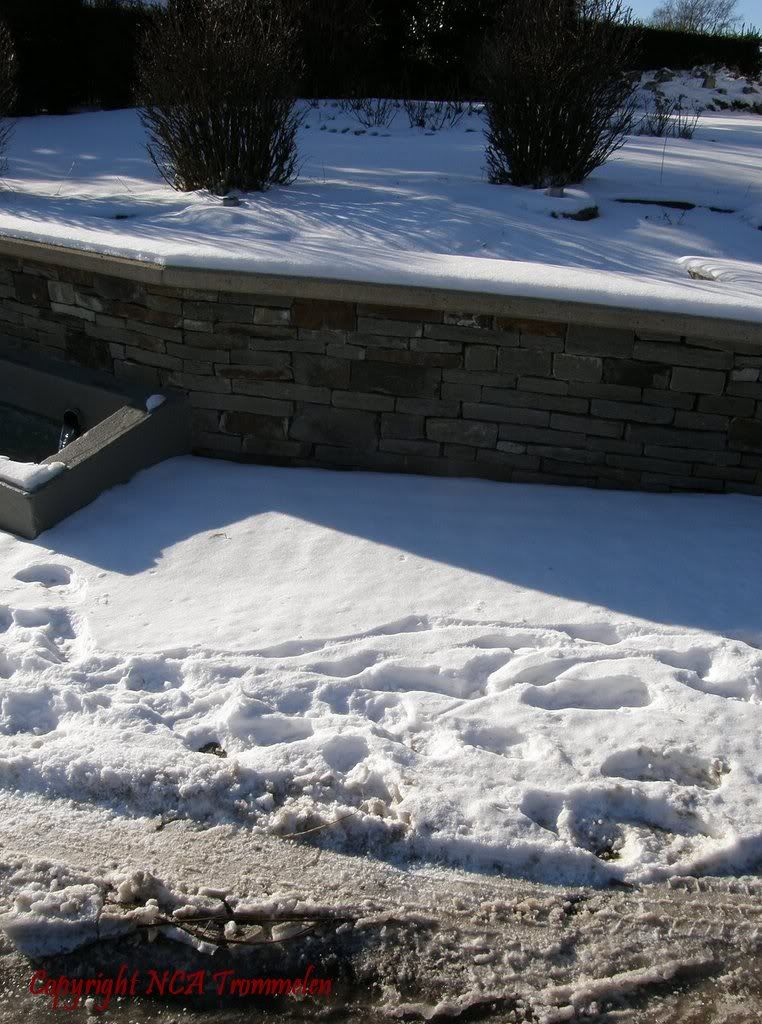
Heavy street fighting at Honsfeld. American soldiers lay died in the mud. While the German Fallschirmjägers are trying to fit their boots.

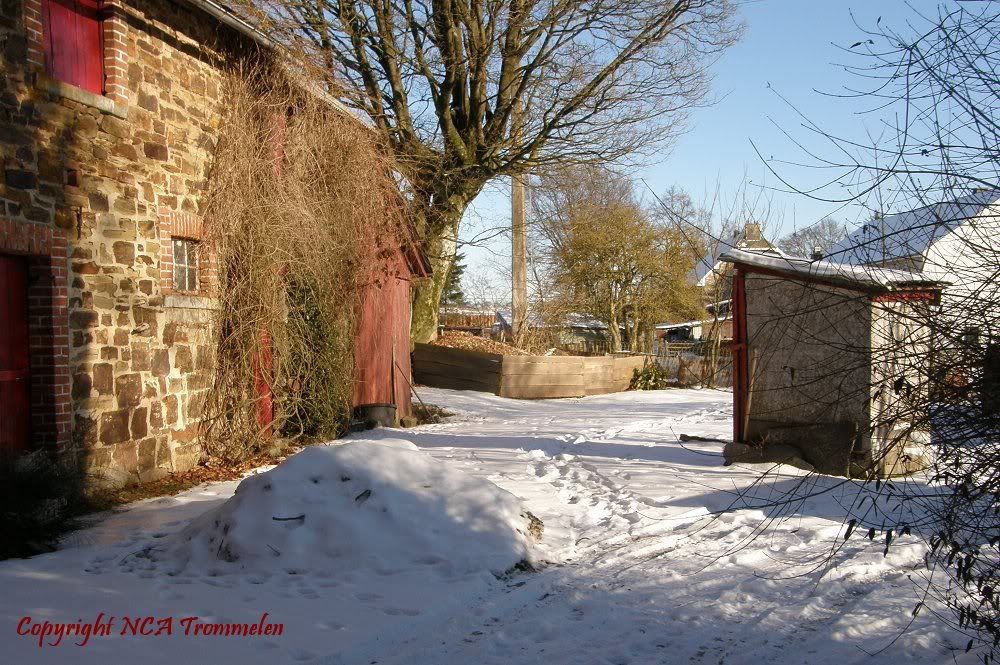
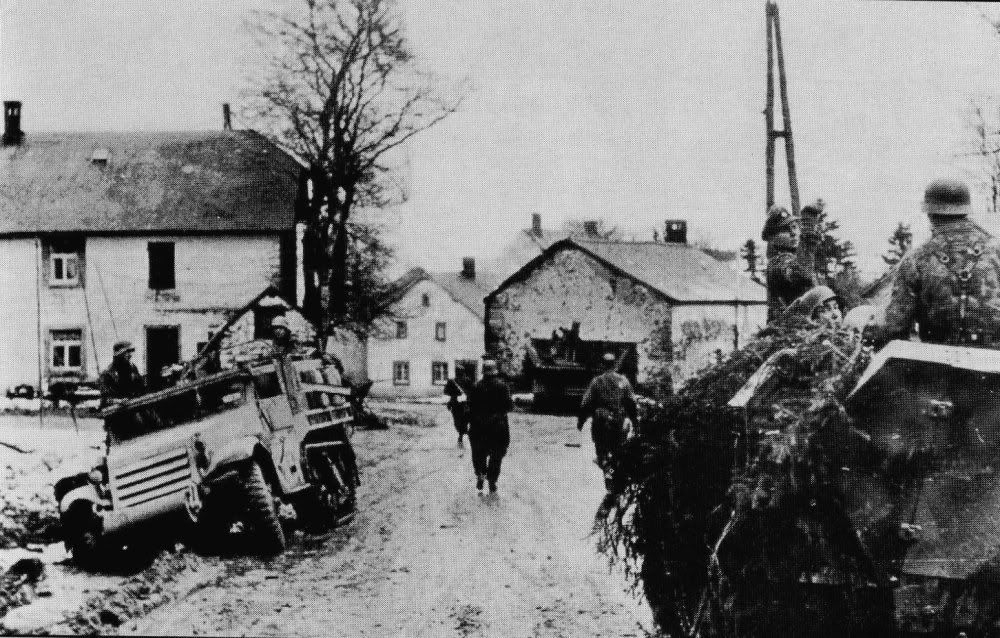
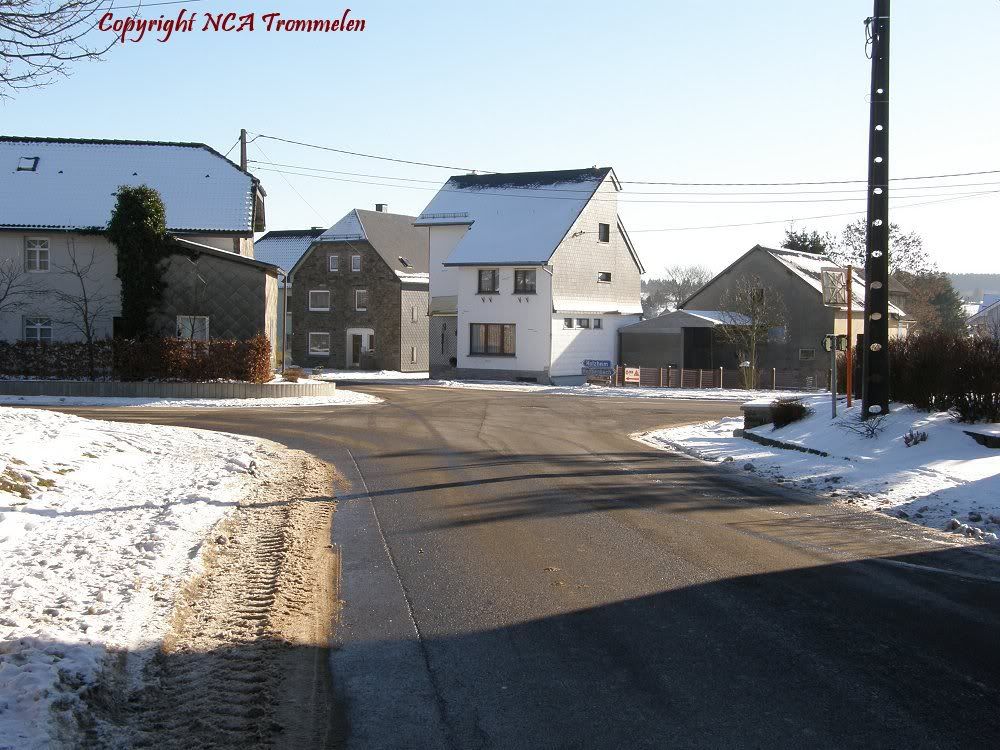
There Honsfeld was a US resting-center, the Germans captured huge amounts of supplies and material.
After the capture of Krewinkel, Manderfeld and Holzheim, the Regiment together with the FJR.8 was on its way towards Bütgenbach, and Waimes.
This will be the end stop for most units of the 3. Fallsch.Jg.Div.
Parts of the I.Batl./5 where able to reach Belair NO of Faymonville, as parts of the I.Batl./9 captured Steinbach and Faymonville. The III.Batl./9 captures Onderval on the 20th December 1944, and will later be able to capture Thirimont as well.
After the 20th of December the frontline of the 3. Fallsch.Jg.Div. was with the FJR.9 in the West/NW between Thirimont, towards Steinbach (Waimes) and at Faymonville, the FJR.8 and FJR.5 where assigned to the area to the North, between Faymonville and forest Bütgenbacher Heck.
The Gefechtstand of the 3. Fallsch.Jg.Div. will be at Möderscheider mühle, and the Gefechtstand of the FJR.5 will be at Möderscheid itself. The Gefechtstand for the FJR.8 will be at Schoppen and the Gefechtstand for the FJR.9 is at Montenau and Stephanshof.
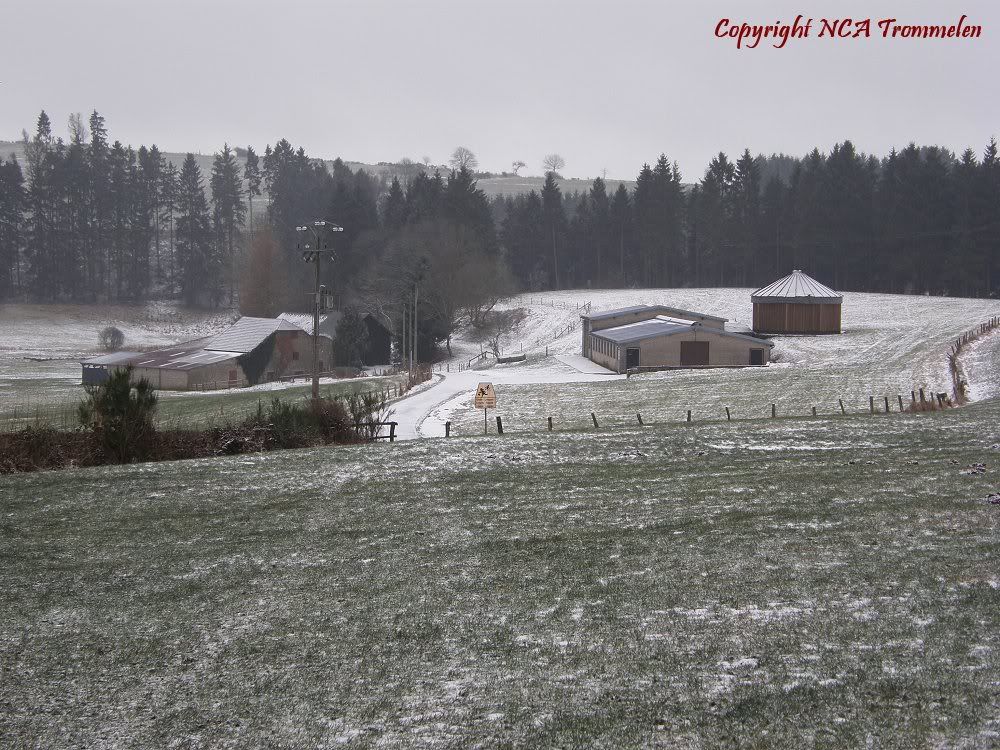
This picture shows the Möderscheider mühle in 2009, back then in 1944/1945 it was Gefechtstand for the 3. Fallsch.Jg.Div.

And here the Gefechtstand of FJR.9, at Am Kloster near Montenau also in 2009.
In the following days of December 1944 many fights occur in the region of Waimes and Bütgenbach. As the Germans try to get through.
In the days to follow the initiative will switch back to the Americans as they are to one who will launch attacks against the 3. Fallsch.Jg.Div. and other neighboring German units. On the December 19th a heavy counterattack by the Americans is repulsed at Hof Rutier, north of Faymonville.
The FJR.5 frontline now moves between Mon Antoine – Bütgenbacher Hütte – Bütgenbacher Heck. Whereas the II. Batl. of Richter will have positions at the place where the railroad bends; between Mon Antone and the Klingesberg.
Where from the 20th of December many US counterattacks were repulsed by the Fallschirmjägers of the II. Batl./5.
It is here between Mon Antone and Klingesberg that Fhj./Ofw. Johannes Richter again will be wounded in battle for the third time, while he is Zügfuhrer in the 6. Kompanie.
He was hit by grenade shrapnel on his forehead, but again this injury doesn’t seem to be heavy. And he continues to stay at the frontline.
This will earn him the Verwundeten Abzeichen in Silber now, and 3 days later on the 24th of December he also receives the Eisernes Kreuz II. Klasse for his actions in the vicinity of Schoppen.
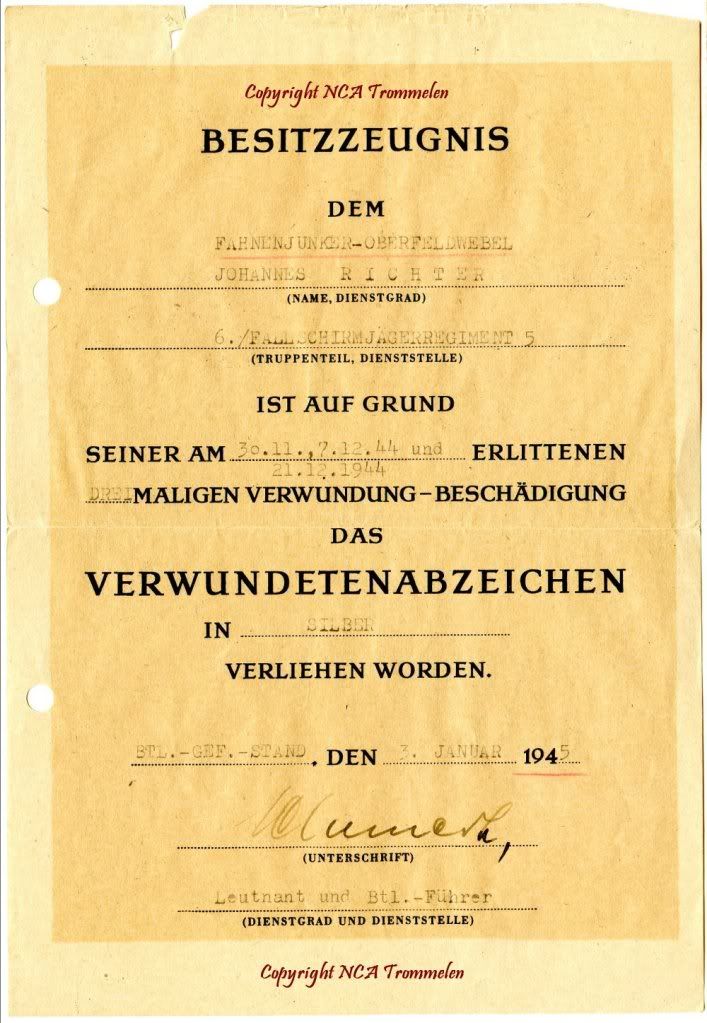
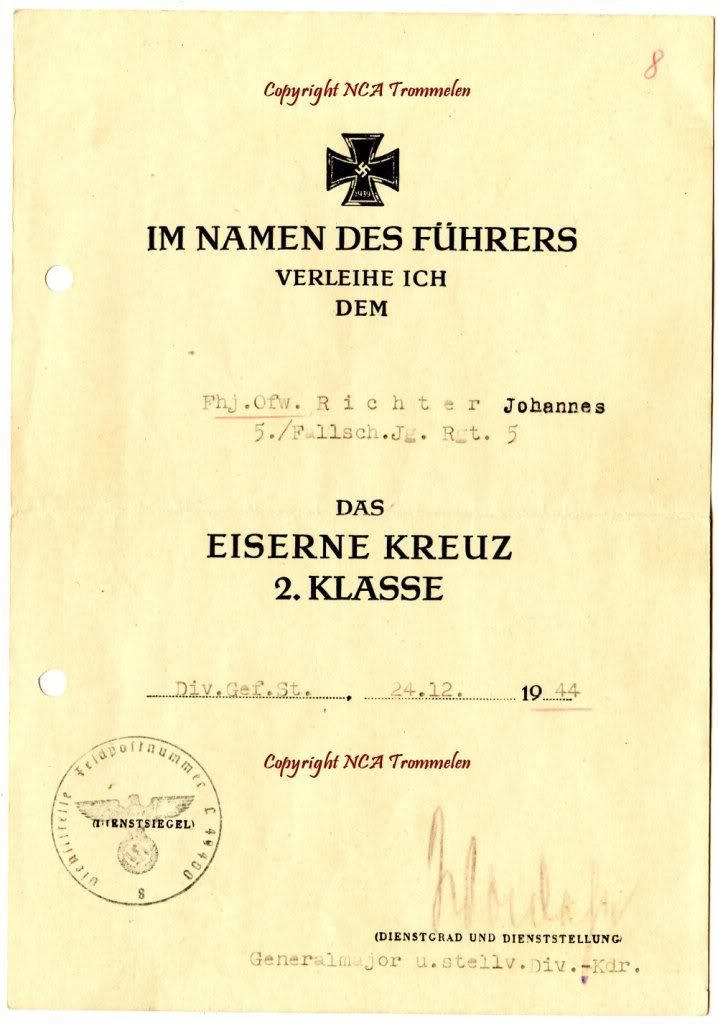
The 2 documents for his VWA in Silber and his Eisernes Kreuz II. Klasse.
The VWA document is again signed by Adolf Klammert, II.Batl./5 Führer.
The Eisernes Kreuz II. Klasse document is signed by the commander of the 3. Fallsch.Jg.Div. Generalmajor Walter Wadehn, probably at the Möderscheider mühle.
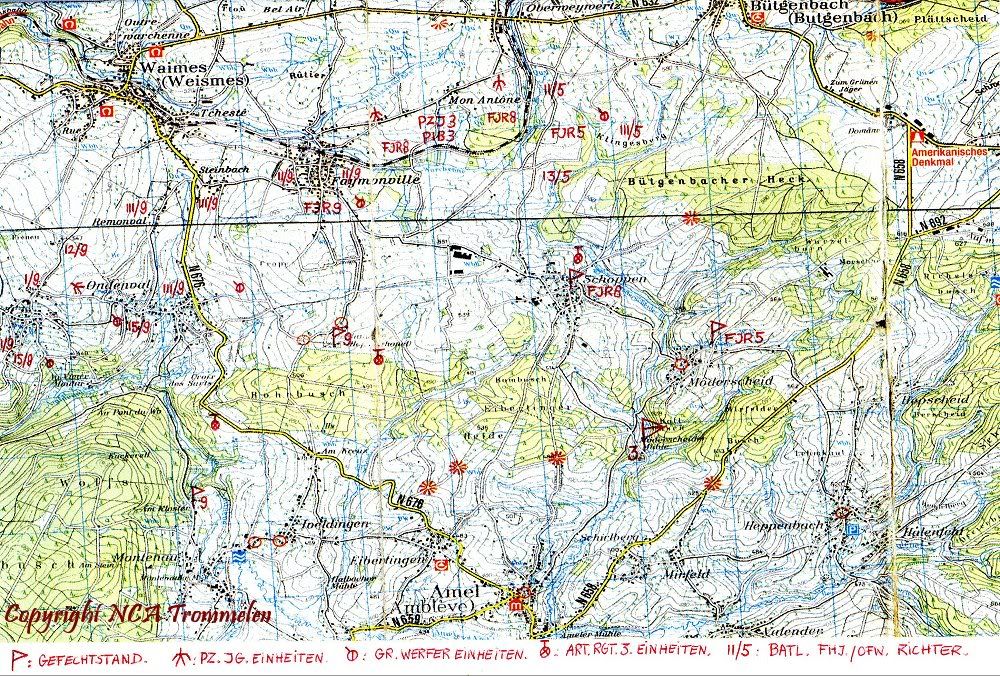
Map showing the positions of different Battailons of the 3. Fallsch.Jg.Div. mid January 1945.
The Americans tried to overrun the thinly spread German frontline of the I.Batl./5 between Oberweywertz and Bütgenbach early January. But this HKL is held till mid January 1945.
The II.Batl./5 at Mon Antone is attacked on the 15th of January 1945, as many other American troops will attack in a large scale offensive to crush the German troops in this region, they were successful, but progress was made slowly against the stubborn defenses of the 3. Fallsch.Jg.Div.
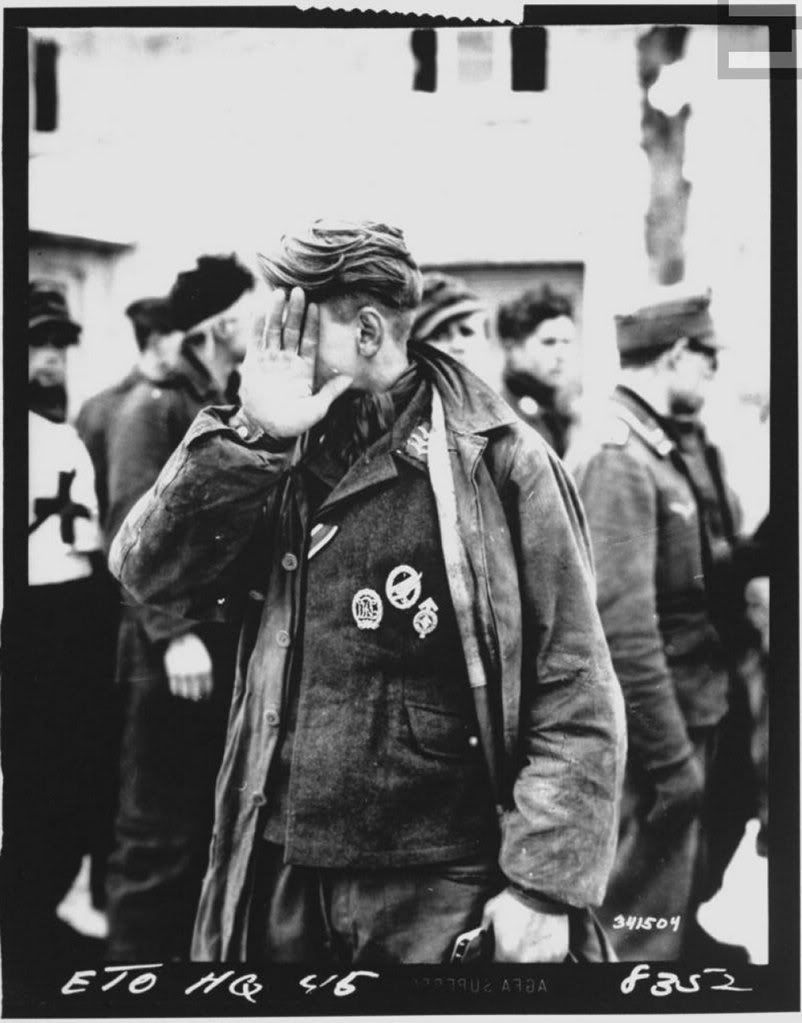
One of the first prisoners of the US. 16. Infantry Regiment in the mid January offensive.
This Fallschirmjäger is captured at Weywertz, on January 15. It could be very well possible that he belonged to the II.Batl/5 of Richter or the III.Batl./5, if we are looking at the location of capture.

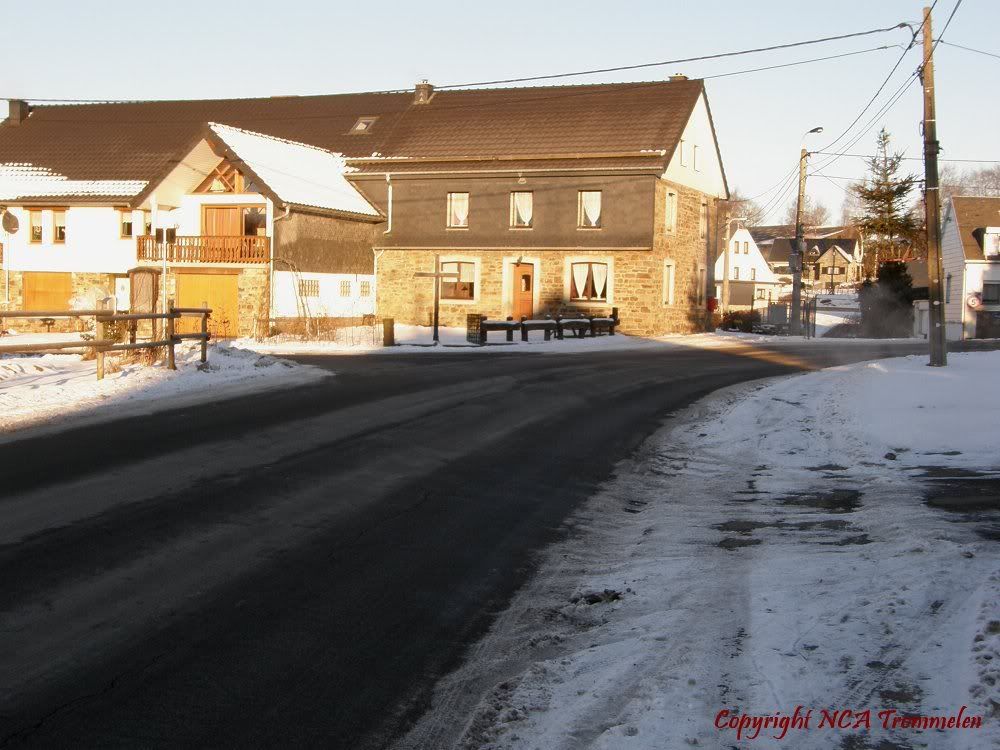
Faymonville, recaptured from the FJR.9 by the 1. US "Big Red One" division. On the 16th of January.
A dead Fallschirmjäger lays aside the road.
From Fhj./Ofw. Richters 6. Kompanie, Hauptmann Wendt was killed in action during these US attacks in mid January. And Zugführer Oberfeldwebel Rehkopf was taken prisoner together with 36 soldiers of his Zug (II.Batl./5).
On the location SE of Mon Antone, around 40 other members of the 6. and 8. Kompanie (II.Batl./5) where captured.
Americans are shelling the entire area intensely with phosphor grenades which results in more casualties in the II.Batl./5 of Richter. By know the frontline is running from Dom Bütgenbach – Bütgenbacher Heck towards Shoppen.
By mid/end January the Americans where broken through the entire sector of the 3. Fallsch.Jg.Div.
Faymonville has fallen, together with Thirimont and Ondenval. And heavy fighting occuried in the Rohrbusch and Bambusch wooded areas, where the FJR.9 held bravely against heavy American attacks.
With the Americans on their heels the entire 3. Fallsch.Jg.Div. was retreating to the east and a new HKL was formed at Bütgenbacher Heck - Möderscheid – Heppenbach.

Deathcard above shows a fallen Fallschirmjäger who got killed during the American offensive in January. His life ended in the woods at Rohrbusch, where the Fallschirm Regiment 9 together with the Panzerjäger Abteilung 3 was on the retreat. Georg Schmerold, a Gruppenführer belonged to the Fallschirm Panzerjäger Abteilung 3 is buried in Recogne.
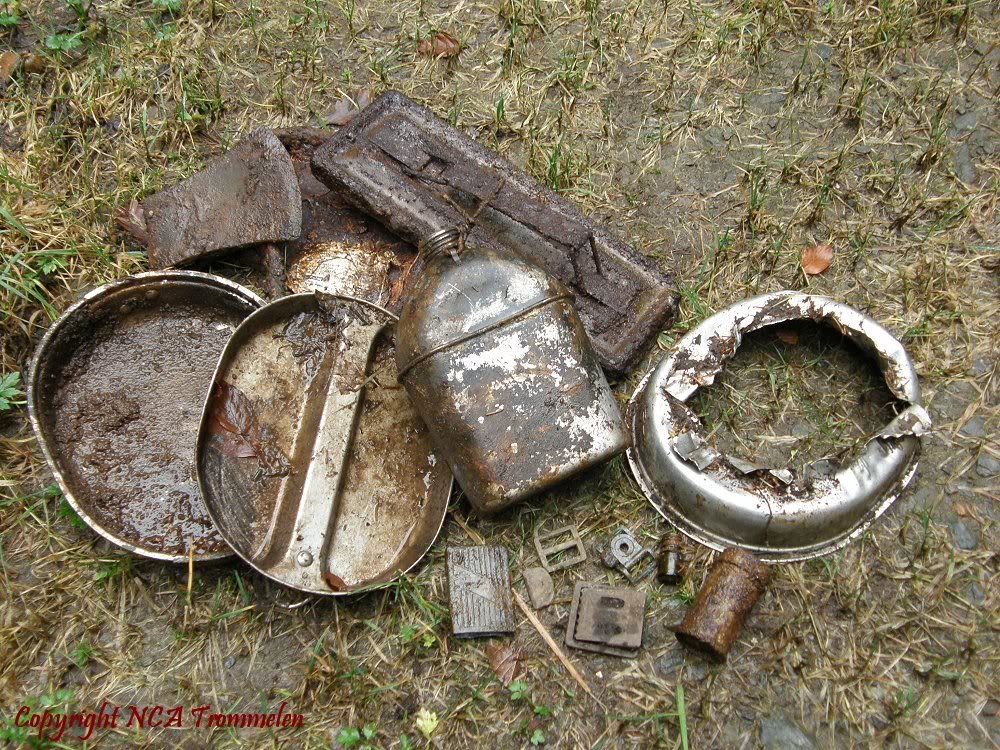
Relics I found end December 2009 when I was wandering through the woods of Bambusch, East of Schoppen.
Near a tree and some German dugouts of the FJR.9 I found a US canteen, with a messtin set. The messtin lid to the right shows very well how the fighting was in this area. Its blown apart!
The I.Batl./5 was engaged in the fighting East of Bütgenbacher Heck, near Morscheck. As the II.Batl./5 of Richter was deployed in the vicinity of Hepscheid – Heppenbach, on 24 January 1945 the III.Batl./5 at Möderscheid was attacked fiercely by the Americans, and they had to fall back.
The II.Batl./5, dug in in the forest near Heppscheid received on the 27th of January 1945 an attack by American units, who finally overrun the 6. and 8. Kompanie. Who where retreating back towards the forest in the vicinity of Halenfeld where on 28th of January they will be attacked again by an American armour and infantry. The 6. Kompanie of Richter is then driven back in the wooded area West of Holzheim, where again they will be attacked on the 29th January, the division now heavily weakened is in retreat towards Ingelmondermühle – Lanzerath – Bahnhof Buchholz.
On the last location, where weeks ago the German offensive started, it ended for many of the FJR.5 units. All that was left of FJR.5 was pulling back towards Bahnhof Buchholz, as they encountered the newly arrived and experienced US 82. Airborne Division, “All American”.
Bahnhof Buchholz becomes again the theater of battle, and the FJR.5 will hold this location until 31 January 1945, at the end of the fights at Bahnhof Buchholz the 13./5, 14./5 and 15./5 will be surrounded at the Bahnhof and will be eliminated by the US 82. “All American” division.
The rest of the FJR.5, is pulled back towards Losheimergraben, where the II.Batl./5 of Fhj./Ofw. Richter is engaged in a scattered forest combat, small groups of Fallschirmjäger will encounter the US forces in the wooded area until the 2nd of February 1945. After that, what is over from the regiment will retreat towards the 1st and 2nd Siegfried lines in the Eifel, where it holds positions up to early March 1945.
The II.Batl./5 of Richter couldn’t be called a bataillon anymore after the fightings at Losheimergraben and Bahnhof Buchholz. Losing another 247 man in the Ardennes offensive. The I. and II.Batl./5 together lost 484 men during the fighting in the Ardennes, that’s the strength of an entire new Battalion. The 3. Fallsch.Jg.Div will finally capitulate in the Ruhr and Harz pockets, where the few remaining troops still fought till the end.
Refrences used:
Battle of the Bulge - Then and Now.
Opfergang Deutscher Fallschirmjäger.
Der Vergangenheit auf der Spur.
Zwischen Ritterkreuz und Galgen.
Zerschossene Heimat.
Battle of the Bulge - Through the Lens.
Eric-Jan asked me the show this thread also here on the WAF forum, so here it goes.
A few weeks ago I acquired this Soldbuch of a Fahnenjunker / Oberfeldwebel in the Fallschirmjäger Regiment 5, of the 3. Fallschimjäger division.
Unfortunally the pictures are missing in the soldbuch and driverslicense, but there I have a big passion for the fighting in the Ardennes and Hürtgenwald I couldn't let this one go.
I have quite some books about this battle and unit, and lately acquired another nice book, and in this book I found my owner of the soldbuch twice, as he was Zugführer in the II.Batl./5 (FSJ).
I tried to type out the battles his unit fought (II.Batl./5) and I hope you find it interesting to read.
I also decorated the topic a little bit with some other material I had...
Kind regards,
Nick
Document grouping from:
Fahnenjunker / Oberfeldwebel Johannes Richter
Zugführer in the 6. Kompanie, II. Bataillon,
Fallschirmjäger Regiment 5, der 3. Fallsch.Jg.Div.
Grouping consists of:
Soldbuch Luftwaffe (without picture) issued on 3 September 1939.
Wehrmacht Führerschein issued on 12 January 1940.
Verplichtungsschein, 1 October 1932.
Schiessbuch from the years: 1932, 1933, 1934, 1935, 1936.
Besitzzeugnis Spanien Kreuz in Silber.
Besitzzeugnis Eisernes Kreuz II. Klasse.
Besitzzeugnis Verwundeten Abzeichen in Schwarz.
Besitzzeugnis Verwundeten Abzeichen in Silber.

Johannes Richter which was born on 13 January 1913 in Schwarzenberg, Vogtland. Starts his military carrier on 1 October 1932, signing off for 12 years of service in the German “Heer”.
His soldbuch was issued on 3 September 1940.
Erkennungsmarke No. 145.
Blutgruppe B.

In 1939 he already received the rank of Feldwebel, and on 1 November 1939 a promotion follows listing him as Oberfeldwebel / Hauptfeldwebel. Before that he also earned the Spanien Kreuz in Silber during the Spanish civil war.

Spanien Kreuz in Silber document.

His promotions listed in the soldbuch.
His First unit in the soldbuch is Fliegerhorst Kompanie (E) Dornberg, in this unit he will stay for allmost 4 years. This unit, part of Fliegerhorst Dornberg/Schlempertshof was located near Würzburg. And was build in the beginning of the Poland 1939 campaign.
The unit wasn’t much active, also it was in reserve during the France campaign in 1940.
After the German troops had taken over France in July 1940, the Fliegerhorst was abandoned and the unit moved to France, near Barosmesnil. During this small 4 years of duty with the Luftwaffe, Oberfeldwebel Richter will earn the Kriegsverdiensten Kreuz, II. Klasse mit Schwertern on 6 May 1942.
On July 1943 he stays 2 months with the Reserve Grenadier Bataillon 372, which is reserve for the 372. Infanterie Regiment. In this unit he only will stay a few weeks before he is back again to his old unit: Fliegerhorst Kompanie 40/XIII. Here he will stay again for 8 months.
After that he is transferred to the Seefliegerhorst Kompanie until September 1944.
Until now he had done some easy time in the German army which was losing the war as this point. In desparete need of new men / soldiers many Luftwaffe, Kriegsmarine and other units that where out of “work” because for instance there where no more planes to fly, these men where going to be trained for ground combat.
Oberfeldwebel Richter is transferred to the Fallschirm Schule II on 27 September 1944, where he will see training in the Fallsch.Jg.Ers.Btl. Stendal, which is training new recruits / reserves for the 3. Fallsch.Jg.Div. Just a few days before going to the Ersatz unit, he is promoted to Fahnenjunker / Oberfeldwebel, on 25 September 1944.
During his training he will receive new equipment and also a Karabiner 98 rifle with bayonet, on 5 October 1944.
His training, beginning at the end of September, will only last a poor 6 weeks for he is already send to the frontline unit: the 3. Fallsch.Jg.Div.

His units listed in the Soldbuch.

K98 with Bayonet recieved by the Fallschirm Schule II.
On 11 November 1944, he becomes Zugführer in the 3. Fallschirm.Jg.Div., Regiment 5,
II. Bataillon, 6. Kompanie.
The 3. Fallsch.Jg.Div. who suffererd heavy losses in the Normandy campaign, Falaise Pocket, Mons Pocket and Market Garden campaign was very under strengthened at this point.
Many Ersatz / Replacement units where to follow to strengthen up the Division.
Johannes Richter was one of them.
Hürtgenwald campaign.
The divison who was rebuilding at Oldenzaal (Holland) was send to the frontline near Aachen on November 1944, where the Fallschirmjäger Regiment 5 stays in Reserve near the town of Horm. Other Regiments of the 3. Fallsch.Jg.Div, the FJR.8 and FJR.9 are already thrown into combat in the region of east of Eschweiler, in the triangle Nothberg – Schönthal – Inden, and to the south in the Meroder Wald.
This sector was defended by the 47. Volksgrenadier Div. and 12. Volksgrenadier Div. from October 1944 untill now and was heavily weakenend by US attacks of the 1. US.Infantry.Div. “Big Red One”, and the 3. US.Armoured.Div.
The 12. Volksgren.Div, which consists of the following regiments: Füs.Rgt.27 – Gren.Rgt.48 – Gren.Rgt.89 only consisted of a total of 180 man that were deployed at the HKL (main frontline).
For the 47. Volksgren.Div. the following numbers occur: Gren.Rgt 103 – Gren.Rgt.104 – Gren.Rgt. 115: Has a total of 311 combat ready soldiers at the frontline at the end of November 1944. Looking at this numbers, it makes sence the 3. Fallschirm.Jg.Div. was trown into battle in this region to protect the Allies for advancing to the Ruhr river.
Around the end of November the FJR.9 is deployed to the north between Lamersdorf and Langerwehe with parts of the FJR.8.
Other parts of the FJR.8 and (Rgt.Stab and the I. Batl.) together with the 3. Kompanie of the FJR.5 are deployed to the south between the town of Gey and Haus Hardt.
The Meroder Wald, between Jüngersdorf and Haus Hardt was assigned to the FJR.5
The II. Batl./5 (where Richter was assigned to) was to take positions about 3km’s west of Merode up to 400m south of Jüngersdorf where it was to relieve the III.Batl./5 that already lost about 230 men in this sector, at the first days of fighting.
On this spot they were to hold further attacks made by the 1.US.Infantry.Div. “Big Red One”.
Nonetheless the II.Batl./5 was slowly driven back to the east edge of the Meroder Wald and dug in there on the 28 November 1944.
The US forces, now advancing to Merode itself had launched a major attack on the 3 German Fallschirmjäger Bataillons in the Meroder Wald. The II.Batl./5 got struck by an majority of US forces 1 to 8, and was overrun and pushed back in the town of Merode.
The day after on 29 November 1944 the I.Batl./5 was to attack together with the II.Batl./5 and the Rgt. Units 13., 14 and 15./5 to counterattack the US forces in Merode, and they succeeded . They had driven the Americans back to the forest of Merode.
Immediately after the German success the US forces attacked again with heavy Artillerie preparations, and some of the houses where back again in American hands. As the US forces were halted a few moments later, the 2. Kompanie of the FJR.5 counterattacked, destroying one of the 7 US tanks that were engaged in the fighting. The other 6 tanks, that where under tremendous fire, couldn’t hold it any longer and the crews of the tanks bailed out and ran back to the secure forest of Merode that was in US hands. Leaving 6 US tanks abandoned in the frontline, which were later destroyed with Panzerfausts by the 15./5.
The American infantry still in the outskirts of Merode were hiding in the basements of the houses when they heard that the German Fallschirmjägers got reinforced by an Tiger tank, which was blasting in all the houses that the US infantry occupied.
Many US prisoners were made, and Merode was back in German hands.
On 30 November 1944 Fhj./Ofw. Richter was hit by grenade shrapnel in the upper lef leg. The wound occurred to be only a light one and he stayed on the frontline with his Zug of the 6. Kompanie. The area where he got hit must had been NE of Merode, towards Jüngersdorf.

His wound description in the soldbuch, together with more descriptions of wounds that were to come.
Also his awards are listed on this page.
In the following days many fights where to occur in and around Merode, on 4 December 1944 the recaptured ground between the West of Jüngersdorff and the Forsthaus Merode is defended by the 1. Kompanie and by the 6.Kompanie of Fhj./Ofw. Richter, it is on 4th day of this defence, 8 December 1944 , that Fhj./Ofw. Richter will receive his 2nd injury while defending this heavily fought terrain. He was hit by grenade shrapnel in the right buttocks.
This 2nd wound in a week will earn him the Verwundeten Abzeichen in Schwarz later.

VWA Document showing his 1st and 2nd wound during the battle for Merode. He has been awarded with the VWA in Schwarz.
The document is signed during the Ardennes offensive by Adolf Klammert, leader of the II.Batl./5.
This wound will be received on one of the last days the FJR.5 was in the vicinity of Merode, the following day the Americans will launch a major attack and the Fallschirmjägers where driven back towards the line Obergeich – Konzendorf.
Here they will not hold any long, on the open terrain with the Americans in the higher Meroder Wald above, they are chanceless. Around 10 December 1944 the frontline shifts towards Düren. The fighting’s will continue in the vicinity of Merken – Hoven – Mariaweiler, where the 3. Fallsch.Jg.Div. will engage the US forces till mid December.
The Fallschirmjäger Rgt. 5 was the Regiment with the most casualties of the 3. Fallsch.Jg.Div. during the Merode/Hürtgenwald fighting’s early December 1944, the Bataillon of Fhj./Ofw. Richter will list 430 casualties, of the total 1658 casualties the Regiment had, in that periode of a small 2 weeks.
Ardennes offensive.
The most part of the 3. Fallsch.Jg.Div. was pulled back from the Merken – Hoven – Mariaweiler frontline just a few days before the December 16th,, 1944 = the day the Ardennes offensive started.
The units where send on foot towards Schmidtheim - Hallschlag and Kronenburg, where it received orders to attack on the December 16th.
It must be stated that several units of the 3. Fallsch.Jg.Div. still fought around Düren during the beginning days of the Ardennes offensive! So the 3. Fallsch.Jg.Div. was pretty under strengthened when the Division attacked in the vicinity of Losheim in the early morning of December 16th.
The FJR.5 who had suffered the most losses during the fighting near Merode was ordered to attack together with the FJR.8 towards Krewinkel, a small town on the German border in the vicinity of Losheim. They were ordered to capture the town before 0930 hours in the morning on the 16th of December.
The units that where to attack to town of Krewinkel consisted of the Sturm Zug II. Batl./5, Nachtrichten Zug II.Batl./5, and the 5.., 6., and 7. Kompanie of the II.Batl./5.

Deathcard above is in honour to a Jäger that fell on the first days of the offensive near Scheid (Losheim). Looking at the location of his death he probably belonged to a unit in the Fallschirm Regiment 9.
American units defending the town where the 14th Cav.Group., which was located between the lines of the US 99. Inf.Div to the North from Losheimergraben, and the US 106. Inf.Div. in the Schnee-Eifel.
After intense Artillery preparations by the Germans on the early morning of the 16th they discovered that the US frontlines where not smashed by the Artillery bombardments as aspected. In fact, most of the trenches and dugouts held by the 14th Cal.Group where still intact.
Therefore the fighting in and around Krewinkel by the II.Batl./5, and Richters 6. Kompanie was hard, and they did not manage to capture the town before late afternoon.
The II.Batl./5 was then send to seize the town of Manderfeld, which they did not achieve on the 16th, but only on the 17th of December! Heavy close combat fighting in Manderfeld occurred, after capturing Manderfeld Richter’s II.Batl./5 was order to seize Holzheim the same day, where the fighting was nonetheless the same.


Hallschlag, behind the German frontline. The first American prisoners are shifted to the rear. As the columns of SS and Fallschirmjägers are moving to the front.
As members of the Fallschirm Regiment 5 reached for Holzheim and the terrain surrounding the village. SS Grenadiers and members of the Fallschirm Regiment 9 attacked towards Honsfeld, a village North of Holzheim.
The Germans attacked the village of Honsfeld not knowing it was a resting-center for the 99 US. ID and 14th Cav.Group. Heavy street fighting occurred and at the end of the battle the small town was scattered with dead soldiers, from both sides.


This Sanitäter, fell during the battle for Honsfeld. Allthough the deathcard doesn’t mention anything related to the Fallschirmjäger truppen, I found him back in Frühbeissers book.
Josef Sebald, a Sanitäts-Obergefreiter belonged to the II.Batl./9, 5. Kompanie.
And got hit by a piece of shrapnel in the breast. Ending his life at 37 years in the streets of Honsfeld.
He is buried at the war cemetery in Lommel.

Picture above shows another member of the 3.Fallsch.Jg.Div., who also died on December 17th 1944, the card shows he got killed near Malmedy, but most likely he was also killed in the vicinity of Honsfeld or further towards Bütgenbach. He is also buried at the war cemetery in Lommel.




Heavy street fighting at Honsfeld. American soldiers lay died in the mud. While the German Fallschirmjägers are trying to fit their boots.




There Honsfeld was a US resting-center, the Germans captured huge amounts of supplies and material.
After the capture of Krewinkel, Manderfeld and Holzheim, the Regiment together with the FJR.8 was on its way towards Bütgenbach, and Waimes.
This will be the end stop for most units of the 3. Fallsch.Jg.Div.
Parts of the I.Batl./5 where able to reach Belair NO of Faymonville, as parts of the I.Batl./9 captured Steinbach and Faymonville. The III.Batl./9 captures Onderval on the 20th December 1944, and will later be able to capture Thirimont as well.
After the 20th of December the frontline of the 3. Fallsch.Jg.Div. was with the FJR.9 in the West/NW between Thirimont, towards Steinbach (Waimes) and at Faymonville, the FJR.8 and FJR.5 where assigned to the area to the North, between Faymonville and forest Bütgenbacher Heck.
The Gefechtstand of the 3. Fallsch.Jg.Div. will be at Möderscheider mühle, and the Gefechtstand of the FJR.5 will be at Möderscheid itself. The Gefechtstand for the FJR.8 will be at Schoppen and the Gefechtstand for the FJR.9 is at Montenau and Stephanshof.

This picture shows the Möderscheider mühle in 2009, back then in 1944/1945 it was Gefechtstand for the 3. Fallsch.Jg.Div.

And here the Gefechtstand of FJR.9, at Am Kloster near Montenau also in 2009.
In the following days of December 1944 many fights occur in the region of Waimes and Bütgenbach. As the Germans try to get through.
In the days to follow the initiative will switch back to the Americans as they are to one who will launch attacks against the 3. Fallsch.Jg.Div. and other neighboring German units. On the December 19th a heavy counterattack by the Americans is repulsed at Hof Rutier, north of Faymonville.
The FJR.5 frontline now moves between Mon Antoine – Bütgenbacher Hütte – Bütgenbacher Heck. Whereas the II. Batl. of Richter will have positions at the place where the railroad bends; between Mon Antone and the Klingesberg.
Where from the 20th of December many US counterattacks were repulsed by the Fallschirmjägers of the II. Batl./5.
It is here between Mon Antone and Klingesberg that Fhj./Ofw. Johannes Richter again will be wounded in battle for the third time, while he is Zügfuhrer in the 6. Kompanie.
He was hit by grenade shrapnel on his forehead, but again this injury doesn’t seem to be heavy. And he continues to stay at the frontline.
This will earn him the Verwundeten Abzeichen in Silber now, and 3 days later on the 24th of December he also receives the Eisernes Kreuz II. Klasse for his actions in the vicinity of Schoppen.


The 2 documents for his VWA in Silber and his Eisernes Kreuz II. Klasse.
The VWA document is again signed by Adolf Klammert, II.Batl./5 Führer.
The Eisernes Kreuz II. Klasse document is signed by the commander of the 3. Fallsch.Jg.Div. Generalmajor Walter Wadehn, probably at the Möderscheider mühle.

Map showing the positions of different Battailons of the 3. Fallsch.Jg.Div. mid January 1945.
The Americans tried to overrun the thinly spread German frontline of the I.Batl./5 between Oberweywertz and Bütgenbach early January. But this HKL is held till mid January 1945.
The II.Batl./5 at Mon Antone is attacked on the 15th of January 1945, as many other American troops will attack in a large scale offensive to crush the German troops in this region, they were successful, but progress was made slowly against the stubborn defenses of the 3. Fallsch.Jg.Div.

One of the first prisoners of the US. 16. Infantry Regiment in the mid January offensive.
This Fallschirmjäger is captured at Weywertz, on January 15. It could be very well possible that he belonged to the II.Batl/5 of Richter or the III.Batl./5, if we are looking at the location of capture.


Faymonville, recaptured from the FJR.9 by the 1. US "Big Red One" division. On the 16th of January.
A dead Fallschirmjäger lays aside the road.
From Fhj./Ofw. Richters 6. Kompanie, Hauptmann Wendt was killed in action during these US attacks in mid January. And Zugführer Oberfeldwebel Rehkopf was taken prisoner together with 36 soldiers of his Zug (II.Batl./5).
On the location SE of Mon Antone, around 40 other members of the 6. and 8. Kompanie (II.Batl./5) where captured.
Americans are shelling the entire area intensely with phosphor grenades which results in more casualties in the II.Batl./5 of Richter. By know the frontline is running from Dom Bütgenbach – Bütgenbacher Heck towards Shoppen.
By mid/end January the Americans where broken through the entire sector of the 3. Fallsch.Jg.Div.
Faymonville has fallen, together with Thirimont and Ondenval. And heavy fighting occuried in the Rohrbusch and Bambusch wooded areas, where the FJR.9 held bravely against heavy American attacks.
With the Americans on their heels the entire 3. Fallsch.Jg.Div. was retreating to the east and a new HKL was formed at Bütgenbacher Heck - Möderscheid – Heppenbach.

Deathcard above shows a fallen Fallschirmjäger who got killed during the American offensive in January. His life ended in the woods at Rohrbusch, where the Fallschirm Regiment 9 together with the Panzerjäger Abteilung 3 was on the retreat. Georg Schmerold, a Gruppenführer belonged to the Fallschirm Panzerjäger Abteilung 3 is buried in Recogne.

Relics I found end December 2009 when I was wandering through the woods of Bambusch, East of Schoppen.
Near a tree and some German dugouts of the FJR.9 I found a US canteen, with a messtin set. The messtin lid to the right shows very well how the fighting was in this area. Its blown apart!
The I.Batl./5 was engaged in the fighting East of Bütgenbacher Heck, near Morscheck. As the II.Batl./5 of Richter was deployed in the vicinity of Hepscheid – Heppenbach, on 24 January 1945 the III.Batl./5 at Möderscheid was attacked fiercely by the Americans, and they had to fall back.
The II.Batl./5, dug in in the forest near Heppscheid received on the 27th of January 1945 an attack by American units, who finally overrun the 6. and 8. Kompanie. Who where retreating back towards the forest in the vicinity of Halenfeld where on 28th of January they will be attacked again by an American armour and infantry. The 6. Kompanie of Richter is then driven back in the wooded area West of Holzheim, where again they will be attacked on the 29th January, the division now heavily weakened is in retreat towards Ingelmondermühle – Lanzerath – Bahnhof Buchholz.
On the last location, where weeks ago the German offensive started, it ended for many of the FJR.5 units. All that was left of FJR.5 was pulling back towards Bahnhof Buchholz, as they encountered the newly arrived and experienced US 82. Airborne Division, “All American”.
Bahnhof Buchholz becomes again the theater of battle, and the FJR.5 will hold this location until 31 January 1945, at the end of the fights at Bahnhof Buchholz the 13./5, 14./5 and 15./5 will be surrounded at the Bahnhof and will be eliminated by the US 82. “All American” division.
The rest of the FJR.5, is pulled back towards Losheimergraben, where the II.Batl./5 of Fhj./Ofw. Richter is engaged in a scattered forest combat, small groups of Fallschirmjäger will encounter the US forces in the wooded area until the 2nd of February 1945. After that, what is over from the regiment will retreat towards the 1st and 2nd Siegfried lines in the Eifel, where it holds positions up to early March 1945.
The II.Batl./5 of Richter couldn’t be called a bataillon anymore after the fightings at Losheimergraben and Bahnhof Buchholz. Losing another 247 man in the Ardennes offensive. The I. and II.Batl./5 together lost 484 men during the fighting in the Ardennes, that’s the strength of an entire new Battalion. The 3. Fallsch.Jg.Div will finally capitulate in the Ruhr and Harz pockets, where the few remaining troops still fought till the end.
Refrences used:
Battle of the Bulge - Then and Now.
Opfergang Deutscher Fallschirmjäger.
Der Vergangenheit auf der Spur.
Zwischen Ritterkreuz und Galgen.
Zerschossene Heimat.
Battle of the Bulge - Through the Lens.



Comment